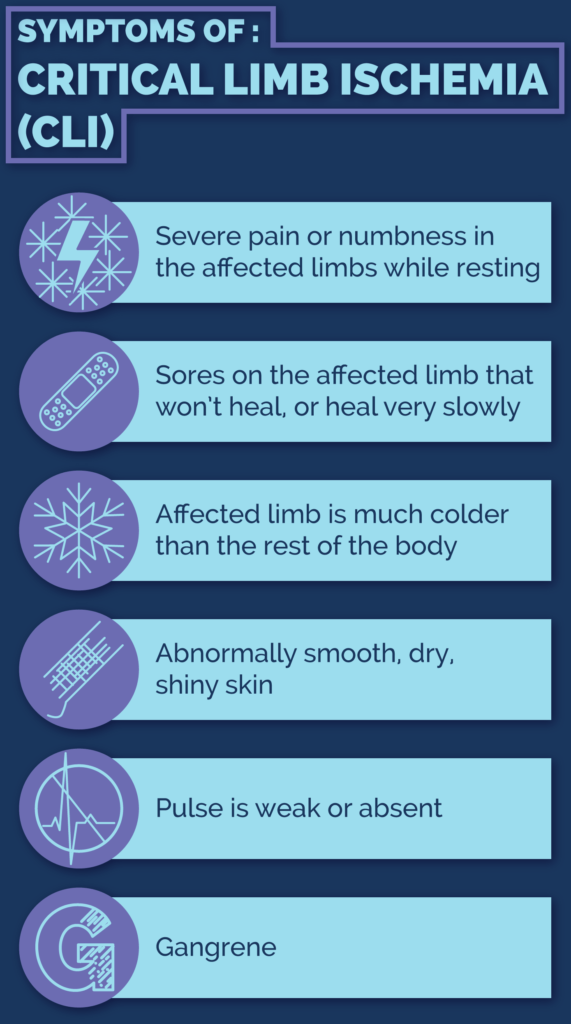Have you, or someone you know, had a sore on their foot that just would not go away? Critical Limb Ischemia (CLI) is the result of narrowing arteries in the leg, which restricts blood flow to your extremities. You may first notice CLI as pain in the foot or an ulceration on the toe. Interventional radiologists perform a minimally invasive procedure to treat CLI called angioplasty.
Article reviewed by Luke Wilkins, MD and John Angle, MD.
What is Critical Limb Ischemia (CLI)?
Ischemia is a condition in which there is inadequate blood flow to some part of the body. Any limb or organ can be affected by this condition. Ischemia is usually the result of atherosclerosis, a condition where plaque, made up of fat, fibrous material, and calcium, builds up in the artery wall, causing them to stiffen and narrow, restricting blood flow.
Critical Limb Ischemia (CLI) is an advanced form of ischemia characterized by a near-complete loss of blood flow to one or both legs, but it can sometimes affect the arms as well. CLI is most often identified by its symptoms, most frequently, pain in the foot and calf that is sometimes relieved by dangling the leg off the side of the bed. Left untreated, the skin can turn blue and sores called ulcers can develop. Severe cases can suffer irreversible damage the foot due to a condition called gangrene, a death of body tissue.
The risk factors for CLI include being over the age of 55, smoking, diabetes, obesity, high cholesterol, high blood pressure, and a sedentary life style. By controlling these risk factors, you can take steps to limit their effect on your arteries and prevent CLI later in life.
Diagnosing Critical Limb Ischemia
Diagnosing CLI depends mainly on what you have noticed and an examination of your foot. Your healthcare provider will run through a number of questions to determine the cause of your symptoms and measure your blood pressure in all four extremities. Your doctor may order other tests to examine the extent of atherosclerosis such as CT, MRI, or ultrasound. If CLI is suspected, your doctor will likely order an angiogram, an map of your blood vessels made using a special dye and x-ray.

A stylized graphic of an angiogram.
Treatment Options
In early stages of CLI, the disease may be able to be treated with medication and an exercise routine set and supervised by your doctor.
Many patients will need a balloon or stent as part of an angiogram. Others may need a bypass, a procedure to replace damaged arteries. During a bypass surgery, the surgeon uses a vein segment from another part of your body (or artificial tubing) to make a path for blood to go around the blocked artery, delivering blood flow to the affected extremity.
Bypass isn’t the only surgical option, but the types of surgeries that are available vary between patients and hospitals.
Angioplasty: A Minimally Invasive Alternative
One common, minimally invasive treatment for CLI is angioplasty. During an angioplasty procedure, vascular specialists, such as interventional radiologists, access narrowed or blocked arteries and inflate a small balloon inside the artery to widen it. This allows normal blood flow to return. In some angioplasty procedures, it may be necessary to place a scaffold, called a stent, to keep the artery open.
Compared to traditional bypass surgeries, angioplasty is much less invasive and has much lower risk of complications. Angioplasty does not require general anesthesia, only local anesthetic, and no surgical incision is made. Because of that, recovery time is much quicker.
In some situations, atherectomy may also be performed to actually remove some of the atherosclerotic material from wall of the narrowed artery. The process can remove a significant amount of disease from the artery, but still a balloon and often a stent are still required.
Next Steps
If you have symptoms of critical limb ischemia, talk to your doctor today about a screening. If you have CLI, contact UVA Interventional Radiology at 434.924.9401 to set up an appointment today.
Infographic Text
- Severe pain or numbness in the affected limb
- Sores on the affected limb that won’t heal, or heal very slowly
- Affected limb is much colder than the rest of the body and may appear red or blue
- Abnormally smooth, dry, shiny skin
- Pulse is weak or absent
- Gangrene




